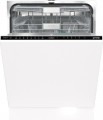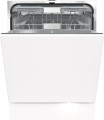Energy class (new)
This parameter characterizes the efficiency of electricity consumption by a dishwasher. Classes are denotet in Latin letters from A to G, in ascending order of energy consumption. Actually, more energy-efficient models have not been added to the A class, which eventually received the marking A +, A ++, A +++. Further development of technology has made it possible to go even further, and in order not to produce pluses in energy efficiency marking, manufacturers returned to the previous indices from G to A in March 2021, where
А is the most energy efficient dishwasher. But also
class B,
C,
D and even
E are also quite economical (no worse than A +++). Accordingly, the 2021 models will have modern markings, while older models will be marked in the same way.
Energy class
The energy efficiency class characterizes the the economy of a dishwasher's electricity consumption. Initially, the classes were denoted in Latin letters from A (high degree of economy) to G (high consumption). But later, with the development of energy saving technologies, more advanced classes than A appeared. They are denoted by the letter A with a certain number of pluses (
A+,
A++, etc.); the more benefits, the higher the economy. Most modern built-in dishwashers comply with energy classes from A to
A+++(the last is 30% more economical than the original class A). More high consumption models, such as classes B and C, are much rarer and gradually disappear.
More economical models cost more, but the difference can be recouped in energy savings. Also note that the energy consumption class does not describe efficiency in general, but in comparison with other similar models; therefore, the actual consumption of a small class A device may be lower than that of a large class A++ model.
Noise class
Allows people to decode the values of the noise level in decibels. It is marked in Latin letters like other classes, where A is the quietest class of dishwashers.
Ultraviolet disinfection
Ultraviolet disinfection is one of the most effective and safest methods of antibacterial treatment. The process of irradiation with UV light usually starts after the end of the main dishwashing cycle. The ultraviolet lamp in the working chamber of the machine is responsible for the operation of the function. UV radiation effectively destroys bacteria, viruses and pathogens without forming harmful substances and without resorting to the use of aggressive “chemistry”. The ultraviolet lamp works when the door is closed, making it completely safe for people. The disadvantage of this function is the rather high cost - UV disinfection is found only in advanced models of dishwashers.
Controls
—
Rotary switch. Rotary switch control. Usually, it is not the only one control: the rotary knob is used to select the operating mode, and the remaining functions of the dishwasher (start-stop programs, timers, etc.) are controlled by buttons. However, panels with rotary switches still have their own specifics, so they are distinguished as a separate type of control. Technically, this option can be used in dishwashers of all price categories, but for a number of reasons, it is found mainly in inexpensive models.
—
Push-buttons. Controlled by classic mechanical buttons. This option allows you to work even with the very advanced and extensive functionality that is typical for premium dishwashers, while the buttons are cheaper than the
touch panels (see below). Therefore, push-button control can be found in all classes of dishwashers, from low-cost to top-end ones. Its main disadvantage is the presence of slots between the buttons and the panel in comparison with the same sensors, where dirt can clog and cleaning out it can be quite difficult.
— Touch. Control systems with sensors. These controls are easier to operate than simple buttons (see above) — instead of pressing, a light touch is enough. All sensors can be made under the same plane, which makes it easier to clean the control panel and reduces the number of places where dirt can clog. Do not forget t
...hat such control gives the dishwasher a modern and advanced look. On the other hand, sensors are more expensive than other types of control, and therefore are used mainly in high-end models.
